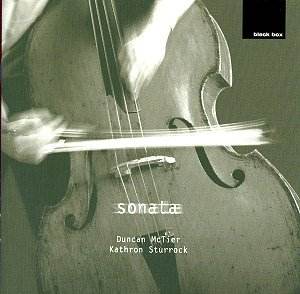I donít think that, before now, I had ever actually
sat down and listened to an entire programme of music for the double-bass,
and the occasional demonstration that has come my way has tended to
reinforce the common view that the instrument is too clumsy for a solo
role except, maybe, a comic one. Well, if all double-bass players (or
even just a fair number of them) could play their instrument as well
as Duncan McTier I daresay double-bass recitals and CDs would be commonplace.
In this, his third CD for Black Box, he concentrates
on sonatas, and two out of three were actually written for his instrument
while the Schubertís "Arpeggione" Sonata, unless anyone were
to reconstruct the instrument of that name, is destined always to be
heard in some transcription or other. The cello is perhaps most usual,
but Iíve heard it on the viola and (transposed) on the clarinet, so
why not the double-bass?
Why not indeed, when we get as singingly lyrical a
performance as Iíve ever heard. The double-bass does not have the ping
of the celloís upper register, with its modern metal-coated strings,
but nor did the all-gut cello of Schubertís day and I was often reminded
of a period instrument. The double-bass sings more gently, but sing
it does, and the faster passage-work contains not a hint of clumsiness.
With very positive support from Sturrock this is as rewarding performance
of the "Arpeggione" as you could hear.
It is an axiom that Hindemith wrote a sonata for every
instrument on principle, but this one has a lot going for it. It reminds
me of Shostakovich 6 inside-out in that it begins with two very brief,
pithy movements, setting the stage for a deeply felt and extended "Molto
adagio" which, is actually very varied, containing both warm, chorale-like
writing and more dramatic moments. Hindemith exploits interestingly
the sonorities to be obtained by having the piano high in its upper
register while the double-bass growls away far below. Fascinating.
Information on Frantiöek Hertl is hard to come by;
the notes (by Sturrock) give neither his dates nor that of the Sonata
and, while his name crops up on several Internet sites, there is a shortage
of hard facts. He was Czech and taught the double-bass at Prague Conservatoire
in the mid-years of the 20th
Century. As a member of the Czech Nonet he adapted the DvořŠk op.
44 Serenade for this organic and he was also a conductor. His Sonata
is a well-made piece in a romantic-modern idiom. No specifically
Czech characteristics emerge but he certainly knows how to show the
instrument to its best advantage and writes for the piano as a fully
equal partner. There is not the authority and drive of a real composer
but itís a likeable piece all the same.
If you want to know what the double-bass can do, and
maybe even if you think you donít, you should get this.
Christopher Howell


